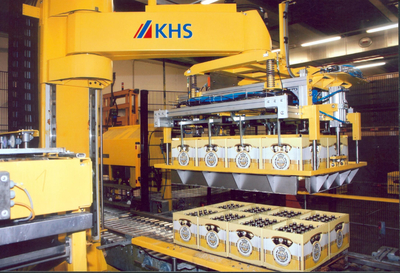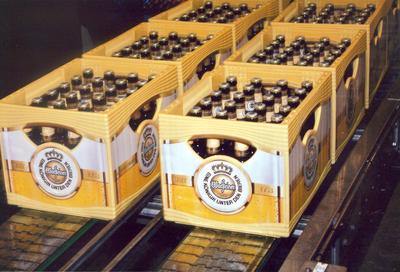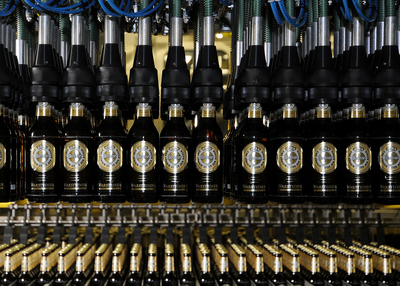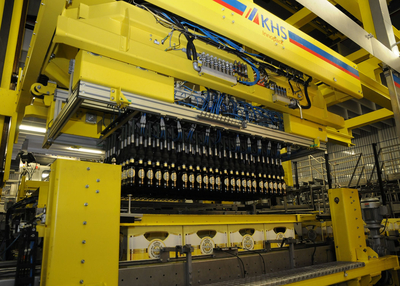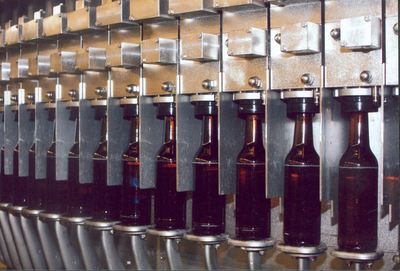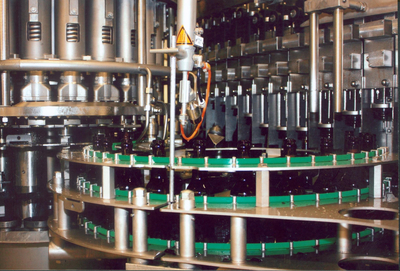
A Premium without Compromise
Warsteiner Group lives up to its premium philosophy on all fronts, again choosing KHS technology
Günter Unkrig*
Andreas Waldscheck**
Consistently Premium – this is the philosophy of the privately managed Warsteiner Group in Germany. Albert Cramer, the owner of the Warsteiner Group, sums it up when he says "Our goal is an ambitious one. Using the most modern technology, we want to make the best beer in the world. For us, the word premium is much more than just a label; it means a commitment. That's why we consistently invest in the entire value-added chain, with the customer at the center of our work." The above quote underlines the fact that within the Warsteiner Group premium is much more than just a mere turn of phrase; it is an entire concept that is implemented from the very start – namely with the selection and strict control of the raw materials used for the beer. It further describes Warsteiner's above-average high standards of quality that are the basis for processing raw materials and producing beer. Premium also stands for eye-catching product presentation at the point of sale. The strategy is naturally at the heart of various sponsoring activities as well as of the new Warsteiner advertising campaign, which emphasizes above all "the desire for pure enjoyment". This again goes to show just what is so important to the Warsteiner brewery: the product, the product and nothing but the product – in premium quality, of course. With such an intense and genuine fixation with the premium concept, it's obvious that every single investment within the Warsteiner Group is carefully checked to see if it meets the premium criteria. The brewery's newest investment in filling and packaging technology is no exception. As a long-term, trusted partner, KHS was once again commissioned with the delivery of a refillable glass line that can process 55,000 0.33-liter or 50,000 0.5-liter glass bottles per hour. Peter Himmelsbach, Technical Director at the Warsteiner Group, says "Because we are extremely satisfied with their technical systems, we traditionally rely on filling and packaging technology from KHS. The new KHS glass line is also a real highlight and perfectly blends in with Warsteiner's overall premium strategy."
* Director, Central European Business Area, KHS AG, Dortmund,
Phone: +49 (231) 569-1602
** Sales Manager for North Germany, KHS AG, Dortmund,
Phone: +49 (231) 569-1734
Group sales of 6.2 million hectoliters
Looking at the development and history of Warsteiner Brauerei, it becomes clear just how great an effect a consistent pledge to premium products and services can have.
Founded in 1753, Warsteiner has been one of the biggest breweries in Germany since the 1960s when its yearly production totaled 100,000 hectoliters. Despite significant success on the domestic market, Albert Cramer was quick to seize opportunities outside Germany. This helped make Warsteiner Brauerei and the entire Warsteiner Group what it is today.
The Warsteiner Group presently clocks up sales of 6.2 million hectoliters, with 2.2 million hectoliters ascribable to sales outside Germany. The main export over the past 25 years has been Warsteiner's Premium Verum brand. About 800,000 hectoliters are currently being exported to more than 60 countries, the main destinations being Italy, the Netherlands, the U.S.A., Great Britain, and Spain.
Acquisitions, partnerships, alliances and license agreements all adhere to the premium concept
With an eye on the future, over the past few years the Warsteiner Group has invested in a number of national and international breweries, partnerships, and alliances. Himmelsbach remarks "Here, we carefully considered which companies would best harmonize with Warsteiner's premium concept. Outside Germany we pay particular attention to markets with a high growth potential."
Within Germany, the Warsteiner Group comprises Warsteiner Brauerei itself, plus the breweries Herforder Brauerei, Paderborner Brauerei, and Frankenheim Brauerei. The group is also affiliated with König Ludwig Schlossbrauerei Kaltenberg.
In 1994, the Warsteiner Group founded Casa Isenbeck brewery in Argentina, a subsidiary that has been successfully producing the Isenbeck brand for the Argentine market since its launch. The Warsteiner Group also considers the African market a good choice for future investment and has thus recently embarked on a joint venture with the Castel Group from France, an international beverage company that has 41 breweries operating in no less than 18 African countries. "This collaboration is a great opportunity for us. It enables us to gradually introduce Warsteiner to Africa as a premium beer and to increase our share of the market on this continent", says Catharina Cramer, managing partner of Warsteiner's ninth generation.
As if this wasn't already enough, the Warsteiner Group is also cooperating with Diageo (Guinness/Kilkenny) and has taken on the sales and marketing of these Irish beers throughout Germany. It also has a license agreement with Efes Brewery in Moscow.
"We have evolved from just Warsteiner Brauerei into an international beverage group", states Albert Cramer. And an end to this development seems to be nowhere in sight. "In the future we'd like provide the upmarket food and beverage trade worldwide with a complete portfolio of first-class beverages for every occasion and every taste that bear the hallmark of German quality," he goes on to observe, clearly outlining present goals of the Warsteiner Group.
Star beer Warsteiner Premium Verum
But let's get back to the origins and core of the Warsteiner Group: the German market. For this is where the heart of the group's success truly lies: in the Warsteiner brewery. The company's star product is and always has been Warsteiner Premium Verum, one of the most popular beers in Germany. This premium brand accounts for 95% of the total production in Warstein. The remaining 5% is down to the mixed beer beverages Warsteiner Premium Lemon, Cola and Orange, Warsteiner Premium Radler (shandy), and also Warsteiner Premium in its non-alcoholic version. At 0.0% alcohol, Warsteiner Premium Alkoholfrei is one of the few genuinely alcohol-free Pilsners on the German market. Consumers seem to appreciate this – and also the taste experience. Sales of Warsteiner Premium Alkoholfrei rose steeply in the first half of 2008 by a dizzy 17.5%.
Ear to the ground
"We are constantly monitoring developments on the German beer market", explains Peter Himmelsbach, "and would only expand our product range if there is a real call for it – and if the premium aspect is guaranteed."
Warsteiner also always has its ear to the ground with regard to packaging and containers. "Innovation from tradition" is the company motto – and this is clearly demonstrated in its selection of crated beverages alone, with Warsteiner products sold in 11, 12, 15, 20, and 24-bottle crates. It also has refillable bottles in the 0.25-liter and 0.33-liter variety and the 0.5-liter longneck. Refillable kegs vary in size from 5 to 50 liters, a range perfectly tailored to suit both the consumer and the restaurateur. Warsteiner's spectrum of non-refillables consists of the 0.33-liter and 0.5-liter can and the above bottle volumes packed in various types of packaging primarily destined for export.
Hot favorites: refillable 0.33 and 0.5-liter longnecks in crates of 20 or 24
"We have the right style of packaging in our portfolio for every customer need," says Himmelsbach. "As always, the hot favorites here are the crates holding 24 refillable 0.33-liter longneck bottles and those containing 20 0.5-liter refillable longnecks." This also explains the breakdown in percent of the various Warsteiner bottles, kegs, and cans: 70% falls to refillable glass bottles, 20% to kegs, 5% to non-refillable glass bottles, and 5% to cans.
New KHS equipment fits the bill
With this distribution in mind, it's thus hardly surprising that the new KHS systems technology Warsteiner invested in had to be a line that is able to fill Warsteiner Premium Verum in refillable 0.33-liter glass bottles and then pack them in crates of 24 – either as individual bottles or as six-packs. As an option, the setup can also process refillable 0.5-liter glass bottles in 20-bottle crates. Ulrich Brendel, Technical Manager at the Warsteiner brewery, says "We have also kept our options open regarding the filling of mixed beer beverages on the line". The new KHS line is connected to an upstream depalletizer and sorting center that supplies segregated empties to the line, an aspect that considerably promotes the high level of line efficiency. The new KHS line is also positioned directly opposite a KHS line previously put into operation in 2005, allowing synergy effects to be exploited, such as the extremely efficient deployment of personnel.
Double act Innopack PPZ
An Innopack PPZ decrating robot unpacks the crates in the line. Brendel explains "This is a packing system that has proved its worth here on several counts. That's why we also use the Innopack PPZ all-rounder to pack the crates."
The Innopack PPZ is extremely flexible and is outstandingly suitable for use as both a decrater and a crater. One clear advantage of this packer concept is that its compact, lucid design allows the Innopack PPZ to be integrated into the overall system using the minimum of space, while at the same time providing excellent accessibility. Whether used as a crater or decrater, the Innopack PPZ is designed in full accordance with the KHS modular dry area concept. An important component of the modular dry area concept is that the control is handled by only one PC-based computer. Unlike common control concepts, this setup uses just one intelligent system to transmit information to all system components via modern bus technology. A further advantage of the KHS modular dry area concept is that servo motors stand for short cycle times and ensure high performance, coupled with exact adherence to the extremely important positioning accuracy. Movements are generated exclusively by cog belts. This means maintenance-free operation and lower noise levels.
Conveying concept planned down to the last detail
To ensure flow within the line, there are buffer tables integrated between each of the machines. This is the case between the decrater and the bottle washer, for example. The KHS buffer system minimizes the conveying area, thereby saving space throughout the entire line. Glass bottles are transported with very little pressure and noise. They are distributed when they enter the buffer table by an alternating or 'zipper' method that separates the bottle flow past the tip of a permanently mounted diverter plow. Specifically controlled chains guide the bottle flow automatically. Several drives ensure an optimum scaling down of conveying speeds during transport and maintain low-pressure, low-noise transfer of the containers to the outfeed of the buffer system.
Throughout the entire line, Warsteiner Brauerei relies on a sophisticated conveying concept that was developed together with KHS and that takes into account not only the need to cut down on space but also the various levels of line sensitivity. One example of this is the use of Easy Clean conveyors without aseptic gear motors between the decrater and bottle washer and between the first buffer table after the filler and the labeler, and Easy Clean conveyors with aseptic gear motors installed between the washer and filler and the filler and first buffer table. Unlike standard conveyors, Easy Clean conveyors have only a few bolted joints; the components are welded together wherever possible. This produces less contact surface, leaving no niches for dirt to accumulate. The lack of cladding permits an unobstructed discharge of broken glass. Sloped surfaces allow liquids to drain off quickly. At Warsteiner, the highest hygiene level for container conveyors – Hygienic Design – is used at the filler outfeed. The Hygienic Design conveyor includes an integrated interior and exterior cleaning system. The incoming and returning chains are separated. Only welded assemblies are used. What's more, special aseptic gear motors prevent air turbulence.
Innoclean DM for perfect bottle washing results and high degree of environmental friendliness
The Warsteiner brewery deliberately opted for the double-end version of the Innoclean DM bottle washer. "With double-end cleaning technology we are exploiting the consistent separation of dirty containers and clean bottle discharge. This ensures top sanitary conditions", says Brendel. The Innoclean DM includes a high-tech KHS infeed section that has several plus points. The draining of residual liquids is followed by intensive pre-washing, for example. Two rotating tubes spray the bottles internally at high pressure, discharging coarse soiling residue with outstanding efficiency and therefore extending the service life of the caustic. As part of the new infeed section concept, during the pre-wash the bottles are heated by means of an external spray. Wastewater from the washer spray zones that follow the caustic baths is used for this, providing further cooling as a positive side effect. The next step is to feed the bottles through the three-stage pre-heating process, complete with immersion bath and two spray zones, prior to the main wash in a series of caustic baths.
"The cleaning effect is perfect. The Innoclean DM bottle washer is also particularly environmentally friendly, keeping water and energy consumption deliberately low", enthuses Ulrich Brendel. Peter Himmelsbach adds "The conscious decision to opt for energy efficiency, invest in the environment, and act with foresight and permanence is a composite part of the Warsteiner Group's company strategy." KHS' three-caustic concept enables heat recovery not just between the recooling and pre-heating zones but also between the first and last caustic tank. Supplemented by the concept of pre-heating the beer at the filler, at nominal machine capacity the Innoclean DM uses 100 ml of water and 26.5 kJ of energy per bottle. In Warstein, the innovative KHS pump drive system reduces the effective current consumption of the spray pumps in real operation by 40%. Another special feature of Warsteiner's Innoclean DM is that in critical areas the bottle washer is made of stainless steel instead of steel. "This is worthwhile in spite of higher investment costs, since stainless steel lasts considerably longer than steel," Brendel continues.
Low-oxygen filling process ensures premium beer quality
The filling system of choice is the Innofill DRS-ZMS. This filling and capping system is equipped with 168 filling valves and 24 capping elements and ensures the high quality of Warsteiner beer by means of the extremely low-oxygen filling process. Himmelsbach sums it up as follows: "This extremely low-oxygen filling process fully supports our strategy of producing premium beers." Other advantages of the filling system include the short changeover for any switch of product or bottle, high machine availability thanks to the central fill level adjustment, the speed and non-standstill-dependent process, and the adaptation of the filler output to the particular line capacity.
The Innofill DRS-ZMS operates with filling level probes. The pressurizing and filling process is preceded by triple pre-evacuation and double CO2 purging. Exact fill levels are determined by the aforementioned fill level probes. The Innofill DRS-ZMS is coupled with a crowner. The microbiological filler front table and glass housing ensure maximum hygiene.
In order for the beer to have the optimum temperature when filled, it travels to the filler through an Innopro beer preheater. The beer is preheated by a plate heat exchanger operating with circulation water. There are energy-saving components built in here, too, one being that the thermal energy is generated by splash water from the bottle washer. The circulation water cooled during the beer preheating process is also used a second time to cool the sealing water for the vacuum pump in the filler. This is a sophisticated concept that has been worked out right down to the last detail.
Labeling of the filled bottles is handled by an existing cold glue labeling machine that has been integrated into the system design. It dresses the bottles with shoulder, back and neck ring labels.
Packing set changing made simple
Two options are available after labeling: either bottles are directly fed to the crater and packed into crates of 24 or bottles are transported to a multipack packer, where they are turned into six-packs and then put into pin-partition crates holding 24 bottles. This means that if the line is switched from individual bottles to multipacks and vice versa, the format has to be changed. What's special here is that complete packing sets are changed at the press of a button at the display screen. The only manual activity still required involves disconnecting the compressed air hose and electrical connectors from the previous packing set and connecting them to the newly installed one. The KHS format changing system picks up the gripper head, centering frame, and lane plates one after the other fully automatically, parks them, and then picks up the new components required in order to install them automatically one after the other on the packer.
The full bottle crates travel along double-lane conveyors to an Innopal RS 3 that palletizes them in layers of eight crates each. A strapper secures the load on the pallet before it is transported to storage by a multiple stacker.
A win-win situation: Warsteiner Brauerei shows off its KHS technology
Mr. Himmelsbach and Mr. Brendel agree that the new KHS line is "premium in all respects". Coming from Warsteiner, this is a compliment that can't be trumped. It is also true – as profusely emphasized on tours of the brewery where Warsteiner shows off its use of new and innovative KHS technology. Interest in visiting the brewery in Warstein is huge, according to Himmelsbach, especially since the opening of the new visitors' center that gives guests from home and abroad an even bigger insight into the world of Warsteiner. 85,000 visitors a year now flock to the Warsteiner brewery. They are not only offered expert knowledge but also the finest in entertainment. Visitors are taken from the Welcome Center to a Rotarium Multimedia Theater where a short film introduces them to the various activities at the brewery. Then the fun starts: surrounded by a 360-degree screen, the guests revolve on an electrically controlled rotating platform past individual stage sets representing the various stages in the brewing process at Warsteiner. Visitors are thus always at the heart of the action – as they are in the ensuing brewery tour. Himmelsbach says "Time and time again, we see just how interested our crowds of international visitors are in technical systems." Jokingly, Ulrich Brendel adds "The Warsteiner Brauerei is thus making KHS technology popular with consumers around the globe." This only goes to show that KHS and Warsteiner is a win-win situation that can hardly get any better! <iframe style="width: 514px; height: 217px;" id="data_migrate_tx_gpopress_articles__260__article_-iframe" class="editorIframe " src="javascript:void(0);"></iframe>


